It is a common misconception that convicted witches were always burnt at the stake. This certainly happened in
countries in which the Catholic Church held sway, where witchcraft there was viewed as a religious offence.
Images of witches and other heretics being burnt by the Holy Inquisition are dramatic, but this was by no means
a universal practice.
In Protestant countries, notably Britain and the American colonies, the attitude to witches was different.
Witchcraft was regarded as a criminal offence, and the punishments reflected this. Broadly speaking, minor
offences were punished by a combination of imprisonment and the pillory, while causing the death of others
through witchcraft was punished by hanging.
Attitudes to witches reflected social evolution. In the middle ages, witchcraft was not perceived as a serious
problem. There was no legislation relating to witches, and any local issues were dealt with by ecclesiastical
courts. Although the official religion was then Catholicism, such courts did not have the authority to impose
capital punishment.
The first Witchcraft Act
The first English law relating to witchcraft was enacted as late as 1542 by King Henry VIII. This provided
the death penalty for the practice of witchcraft, specifically:
“It shall be Felony to practice or cause to be practiced Conjuration, Enchantment, Witchcraft or Sorcery, to get
money or to consume any person in his body, members or goods, or to provoke any person to unlawful love…”
The 1542 Act was repealed in 1547 by Henry’s son, King Edward VI.
An Act against Conjuration Enchantments and Witchcrafts
A more significant anti-witchcraft law was enacted by Queen Elizabeth I in 1563. Here is a modern transcript:
“If any person shall use practice or exercise witchcraft enchantment charm or
sorcery whereby anyone shall happen to be wasted consumed or lamed in his or
her own body or member or whereby any goods or cattle of any person shall be
destroyed wasted or impaired, then every such offender, lawfully convicted, shall
on his first offence suffer imprisonment by space of one whole year without
bail…and once in every quarter of said year…shall stand openly upon the
pillory…And if any person or persons being once convicted of the same offences
as is aforesaid…does perpetrate and commit the like offence…then every such
offender…being of the said offences the second time lawfully convicted…shall
suffer pains of death as a felon and shall lose the benefit and privilege of clergy and sanctuary.”
A first offence
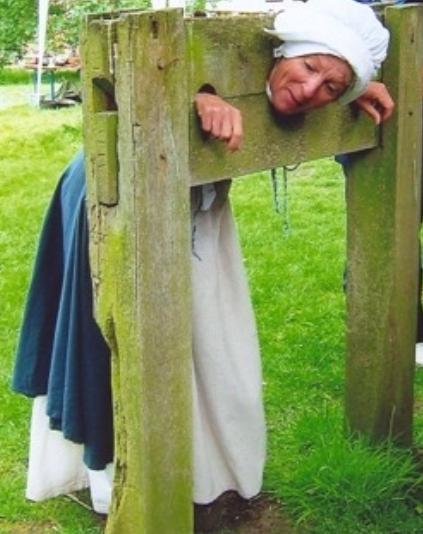 This entailed the convicted witch being pilloried for six hours, and then spending the next three months in jail.
She would then stand in the pillory again for a further six hours, but in a different town to where she had
previously been pilloried. The witch would then be returned to jail for a further three months, then pilloried
again in yet another town. Another three months in jail, followed by her final stint in the pillory in a fourth
town. After a further three months in jail, she would be released.
This entailed the convicted witch being pilloried for six hours, and then spending the next three months in jail.
She would then stand in the pillory again for a further six hours, but in a different town to where she had
previously been pilloried. The witch would then be returned to jail for a further three months, then pilloried
again in yet another town. Another three months in jail, followed by her final stint in the pillory in a fourth
town. After a further three months in jail, she would be released.
This punishment put the local authorities to some trouble and expense in transporting a convicted witch to
different towns. But exposing a witch in four different pillories ensured that she would be notorious over
a very wide area. The purpose was presumably to warn as many people as possible that a potentially dangerous
witch was in the locality. And of course to make it more difficult for a witch to evade scrutiny by simply
moving to the next town.
Elizabeth Francis
In 1566 Elizabeth Francis (of Hatfield in Essex) received this punishment for bewitching a child. In 1572
Elizabeth was convicted of making a woman ill by witchcraft, and was again pilloried and imprisoned. It is
possible that the court was unaware of Elizabeth’s previous conviction, as the punishment for a second offence
should have been hanging. Elizabeth was less fortunate on a subsequent occasion, when she was hanged for
causing the death of Alice Poole by witchcraft.
It is interesting that Elizabeth was not punished for being a witch, but for the harm she had allegedly
caused to others as a result of practising witchcraft. This illustrates nicely the distinction between
criminal and ecclesiastical law in this area.
An Act against Conjuration, Witchcraft and dealing with evil and wicked spirits
King James I was vehemently opposed to any form of witchcraft. His book 'Daemonologie', was a strong
warning against witchcraft and demonic magic. On his accession to the throne, James lost no time in
replacing the 1563 Act with the Witchcraft Statute of 1604.
This legislation increased the punishments for witchcraft. In particular it provided for the death sentence
for a first conviction of malevolent witchcraft, regardless of whether or not a victim had died. It also
became a crime to exhume bodies for magical purposes. The penalty for divining and concocting love potions
remained the pillory and a year in jail.
The 1604 Act also made it a felony to conjure, consult, entertain, covenant with, employ, feed or reward
any evil spirit for any purpose, thus introducing the concept of a pact with the Devil into English law.
Here is an extract from the original text of the 1604 Act:
“…..if any pson or psons shall from and after the saide Feaste of Saint Michaell the Archangell next
cominge, take upon him or them by Witchcrafte Inchantment Charme or Sorcerie to tell or declare in what
place any treasure of Golde or silver should or had in the earth or other secret places, or where Goodes
or Thinges loste or stollen should be founde or become ; or to the intent to Pvoke any person to unlawfull
love, or wherebie and Cattell or Goods of any pson shall be destroyed wasted or impaired, or to hurte or
destroy any Pson in his bodie, although the same be not effected and done : that then all and everie such
pson or psons so offendinge, and beinge therof lawfullie convicted , shall for the said Offence suffer
Imprisonment by the space of one whole yeere, without baile or maineprise, and once in everie quarter of
the saide yeere, shall in some Markett Towne, upon the Markett Day, or at such tyme as any Faire shalbe
kept there, stande openlie upon the Pillorie by the space of sixe houres, and there shall openlie confesse
his or her error and offence….”
The thinking behind this legislation was different to the 1563 Act. It no longer focused on the criminal
consequences of practising witchcraft, but on the inherently criminal nature of witchcraft itself.
Pendle witches
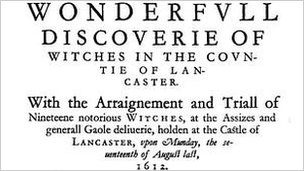 The infamous Pendle witches were prosecuted under the Witchcraft Statute of 1604. In 1612, 20 people were
tried at Lancaster Assizes for witchcraft. Most of them were hanged, although a few were acquitted. Margaret Pearson
(from the nearby village of Padiham) was unusual in that she was tried for three separate offences. Margaret was acquitted
of murder by witchcraft and of bewitching a neighbour, both of which being capital charges. She was also accused
of bewitching a horse. A witness attested that Margaret had "a Spirit in the likeness of man with cloven hoofs, that she
and the Spirit had entered Dodgeon's stable through a loophole and had sat on the mare, which later died".
The infamous Pendle witches were prosecuted under the Witchcraft Statute of 1604. In 1612, 20 people were
tried at Lancaster Assizes for witchcraft. Most of them were hanged, although a few were acquitted. Margaret Pearson
(from the nearby village of Padiham) was unusual in that she was tried for three separate offences. Margaret was acquitted
of murder by witchcraft and of bewitching a neighbour, both of which being capital charges. She was also accused
of bewitching a horse. A witness attested that Margaret had "a Spirit in the likeness of man with cloven hoofs, that she
and the Spirit had entered Dodgeon's stable through a loophole and had sat on the mare, which later died".
On 19 August 1612, Margaret Pearson was convicted of bewitching the unfortunate Mr Dodgeon's horse. Her sentence (according
to the court records) was: “You shall stand vpon the Pillarie in open Market, at Clitheroe, Paddiham, Whalley, and Lancaster, foure Market dayes,
with a Paper vpon your head, in great Letters, declaring your offence, and there you shall confesse your offence, and
after to remaine in Prison for one yeare without Baile, and after to be bound with good Sureties, to be of the good behauiour.”
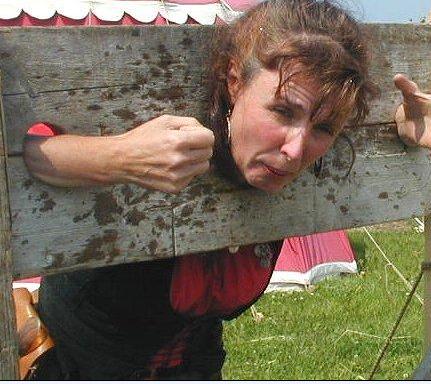 Being pilloried on market days was a more severe punishment. Large numbers of people would have travelled to these
(otherwise quiet) towns and villages to buy and sell livestock and other goods. The prospect of seeing a real life witch (safely locked up in a pillory)
would also have been a considerable attraction. Its fair to assume that the crowds would not have treated Margaret Pearson gently.
Being pilloried on market days was a more severe punishment. Large numbers of people would have travelled to these
(otherwise quiet) towns and villages to buy and sell livestock and other goods. The prospect of seeing a real life witch (safely locked up in a pillory)
would also have been a considerable attraction. Its fair to assume that the crowds would not have treated Margaret Pearson gently.
The last witchcraft trial in Ireland took place in 1711. Eight women (Janet Mean, Janet Latimer, Janet Millar,
Margaret Mitchel, Catharine M'Calmond, Elizabeth Seller, Janet Liston and Janet Carson) were accused of
tormenting a young woman called Mary Dunbar through witchcraft. They were all convicted under the 1604
Witchcraft Statute and each sentenced to be imprisoned for a year, and to stand four times in the pillory
in Carrickfergus.The crowd were “much exasperated against these unfortunate persons, who were severely pelted in the pillory,
with boiled cabbage stalks, and the like, by which one of them had an eye beaten out."
The 1604 Act remained in force in England until 1735 and in the American colonies until 1695. On December 14,
1692, the Massachusetts General Council endorsed the 1604 Act to give "more particular direction in the
execution of the law against witchcraft". The Salem witch trials were mostly indictments under the 1604 Act.
Witchcraft Act 1736
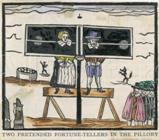 This legislation reveals a complete change in attitude, reflecting a (relatively) more enlightened age.
The Act was aimed at those who pretended to have the power to call up spirits, or foretell the future, or
cast spells. By this time, very few people (and certainly not the authorities) believed in witchcraft. The
1736 Act was essentially anti-fraud legislation, intended to protect the gullible from cheats and tricksters.
Here is an extract from the 1736 Act:
This legislation reveals a complete change in attitude, reflecting a (relatively) more enlightened age.
The Act was aimed at those who pretended to have the power to call up spirits, or foretell the future, or
cast spells. By this time, very few people (and certainly not the authorities) believed in witchcraft. The
1736 Act was essentially anti-fraud legislation, intended to protect the gullible from cheats and tricksters.
Here is an extract from the 1736 Act:
“And for the more effectual preventing and punishing of any Pretences to such Arts or Powers as are before
mentioned, whereby ignorant Persons are frequently deluded and defrauded; be it further enacted by the
Authority aforesaid, That if any Person shall, from and after the said Twenty-fourth Day of June, pretend to
exercise or use any kind of Witchcraft, Sorcery, Inchantment, or Conjuration, or undertake to tell Fortunes,
or pretend, from his or her Skill or Knowledge in any occult or crafty Science, to discover where or in what
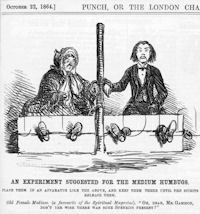 manner any Goods or Chattels, supposed to have been stolen or lost, may be found, every Person, so offending,
being thereof lawfully convicted on Indictment or Information in that part of Great Britain called England,
or on Indictment or Libel in that part of Great Britain called Scotland, shall, for every such Offence, suffer
Imprisonment by the Space of one whole Year without Bail or Mainprize, and once in every Quarter of the said
Year, in some Market Town of the proper County, upon the Market Day, there stand openly on the Pillory by the
Space of One Hour, and also shall (if the Court by which such Judgement shall be given shall think fit) be
obliged to give Sureties for his or her good Behaviour, in such Sum, and for such Time, as the said Court shall
judge proper according to the Circumstances of the Offence, and in such case shall be further imprisoned until
such Sureties be given."
manner any Goods or Chattels, supposed to have been stolen or lost, may be found, every Person, so offending,
being thereof lawfully convicted on Indictment or Information in that part of Great Britain called England,
or on Indictment or Libel in that part of Great Britain called Scotland, shall, for every such Offence, suffer
Imprisonment by the Space of one whole Year without Bail or Mainprize, and once in every Quarter of the said
Year, in some Market Town of the proper County, upon the Market Day, there stand openly on the Pillory by the
Space of One Hour, and also shall (if the Court by which such Judgement shall be given shall think fit) be
obliged to give Sureties for his or her good Behaviour, in such Sum, and for such Time, as the said Court shall
judge proper according to the Circumstances of the Offence, and in such case shall be further imprisoned until
such Sureties be given."
No longer were people to be hanged for consorting with evil spirits. The sole punishment was a year in jail
with four appearances in the pillory. And the time in the pillory was reduced from six hours to one hour on
each occasion.
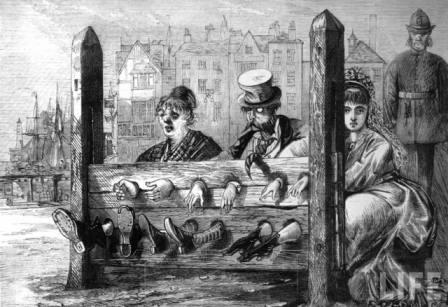 According to the Newcastle General Magazine (published 26 April 1758), on 11 April "Susannah Fleming, stood in the pillory at the White
cross, Newcastle, one hour, pursuant to her sentence, for the first time,
(being to stand once a-quarter, for a year,) for fortune telling.
Though not molested by the populace, she was nearly strangled before
the time was expired, occasioned either by her fainting and shrinking
down, or from having too much about her neck, and being thereby
straightened in the hole. A sailor, out of charity, brought her down
the ladder upon his back, in a nearly dying state."
According to the Newcastle General Magazine (published 26 April 1758), on 11 April "Susannah Fleming, stood in the pillory at the White
cross, Newcastle, one hour, pursuant to her sentence, for the first time,
(being to stand once a-quarter, for a year,) for fortune telling.
Though not molested by the populace, she was nearly strangled before
the time was expired, occasioned either by her fainting and shrinking
down, or from having too much about her neck, and being thereby
straightened in the hole. A sailor, out of charity, brought her down
the ladder upon his back, in a nearly dying state."
Helen Duncan
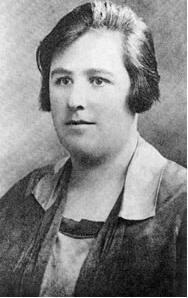 In 1944, Helen Duncan was the last person to be jailed under the Witchcraft Act, on the grounds that she
had pretended to summon spirits. She came to the attention of the authorities after supposedly contacting a
sailor of HMS Barham whose sinking was hidden from the general public at the time. Helen was prosecuted under
the Witchcraft Act because the authorities allegedly feared that she would reveal their secret plans for the
D-Day invasion.
In 1944, Helen Duncan was the last person to be jailed under the Witchcraft Act, on the grounds that she
had pretended to summon spirits. She came to the attention of the authorities after supposedly contacting a
sailor of HMS Barham whose sinking was hidden from the general public at the time. Helen was prosecuted under
the Witchcraft Act because the authorities allegedly feared that she would reveal their secret plans for the
D-Day invasion.
Following Helen’s conviction, the 1736 Act still required that she should stand in the pillory on four occasions.
Fortunately for her, the pillory had been abolished in 1837. Helen spent nine months in prison.
Fraudulent Mediums Act
The 1736 Witchcraft Act was repealed in 1951, and replaced by the Fraudulent Mediums Act.
 Being pilloried on market days was a more severe punishment. Large numbers of people would have travelled to these
(otherwise quiet) towns and villages to buy and sell livestock and other goods. The prospect of seeing a real life witch (safely locked up in a pillory)
would also have been a considerable attraction. Its fair to assume that the crowds would not have treated Margaret Pearson gently.
Being pilloried on market days was a more severe punishment. Large numbers of people would have travelled to these
(otherwise quiet) towns and villages to buy and sell livestock and other goods. The prospect of seeing a real life witch (safely locked up in a pillory)
would also have been a considerable attraction. Its fair to assume that the crowds would not have treated Margaret Pearson gently.
 This entailed the convicted witch being pilloried for six hours, and then spending the next three months in jail.
She would then stand in the pillory again for a further six hours, but in a different town to where she had
previously been pilloried. The witch would then be returned to jail for a further three months, then pilloried
again in yet another town. Another three months in jail, followed by her final stint in the pillory in a fourth
town. After a further three months in jail, she would be released.
This entailed the convicted witch being pilloried for six hours, and then spending the next three months in jail.
She would then stand in the pillory again for a further six hours, but in a different town to where she had
previously been pilloried. The witch would then be returned to jail for a further three months, then pilloried
again in yet another town. Another three months in jail, followed by her final stint in the pillory in a fourth
town. After a further three months in jail, she would be released.  The infamous Pendle witches were prosecuted under the Witchcraft Statute of 1604. In 1612, 20 people were
tried at Lancaster Assizes for witchcraft. Most of them were hanged, although a few were acquitted. Margaret Pearson
(from the nearby village of Padiham) was unusual in that she was tried for three separate offences. Margaret was acquitted
of murder by witchcraft and of bewitching a neighbour, both of which being capital charges. She was also accused
of bewitching a horse. A witness attested that Margaret had "a Spirit in the likeness of man with cloven hoofs, that she
and the Spirit had entered Dodgeon's stable through a loophole and had sat on the mare, which later died".
The infamous Pendle witches were prosecuted under the Witchcraft Statute of 1604. In 1612, 20 people were
tried at Lancaster Assizes for witchcraft. Most of them were hanged, although a few were acquitted. Margaret Pearson
(from the nearby village of Padiham) was unusual in that she was tried for three separate offences. Margaret was acquitted
of murder by witchcraft and of bewitching a neighbour, both of which being capital charges. She was also accused
of bewitching a horse. A witness attested that Margaret had "a Spirit in the likeness of man with cloven hoofs, that she
and the Spirit had entered Dodgeon's stable through a loophole and had sat on the mare, which later died".
 This legislation reveals a complete change in attitude, reflecting a (relatively) more enlightened age.
The Act was aimed at those who pretended to have the power to call up spirits, or foretell the future, or
cast spells. By this time, very few people (and certainly not the authorities) believed in witchcraft. The
1736 Act was essentially anti-fraud legislation, intended to protect the gullible from cheats and tricksters.
Here is an extract from the 1736 Act:
This legislation reveals a complete change in attitude, reflecting a (relatively) more enlightened age.
The Act was aimed at those who pretended to have the power to call up spirits, or foretell the future, or
cast spells. By this time, very few people (and certainly not the authorities) believed in witchcraft. The
1736 Act was essentially anti-fraud legislation, intended to protect the gullible from cheats and tricksters.
Here is an extract from the 1736 Act:

 In 1944, Helen Duncan was the last person to be jailed under the Witchcraft Act, on the grounds that she
had pretended to summon spirits. She came to the attention of the authorities after supposedly contacting a
sailor of HMS Barham whose sinking was hidden from the general public at the time. Helen was prosecuted under
the Witchcraft Act because the authorities allegedly feared that she would reveal their secret plans for the
D-Day invasion.
In 1944, Helen Duncan was the last person to be jailed under the Witchcraft Act, on the grounds that she
had pretended to summon spirits. She came to the attention of the authorities after supposedly contacting a
sailor of HMS Barham whose sinking was hidden from the general public at the time. Helen was prosecuted under
the Witchcraft Act because the authorities allegedly feared that she would reveal their secret plans for the
D-Day invasion.
